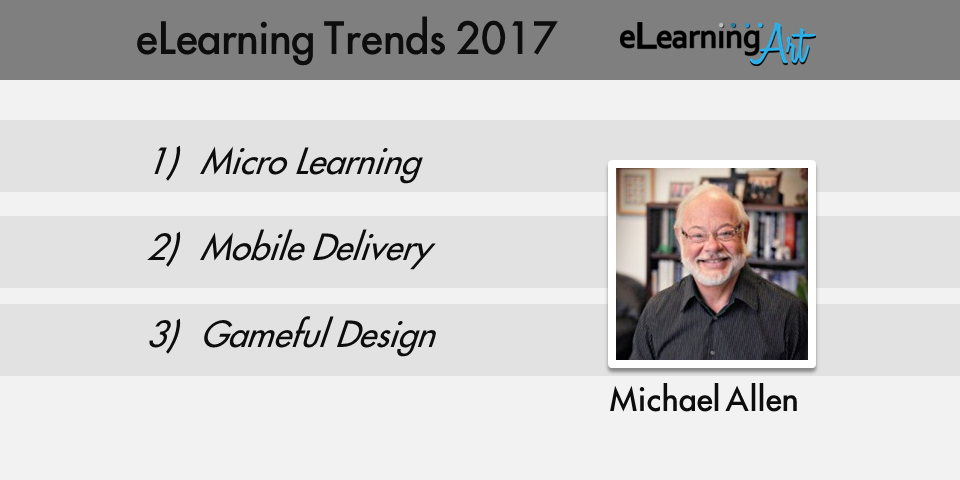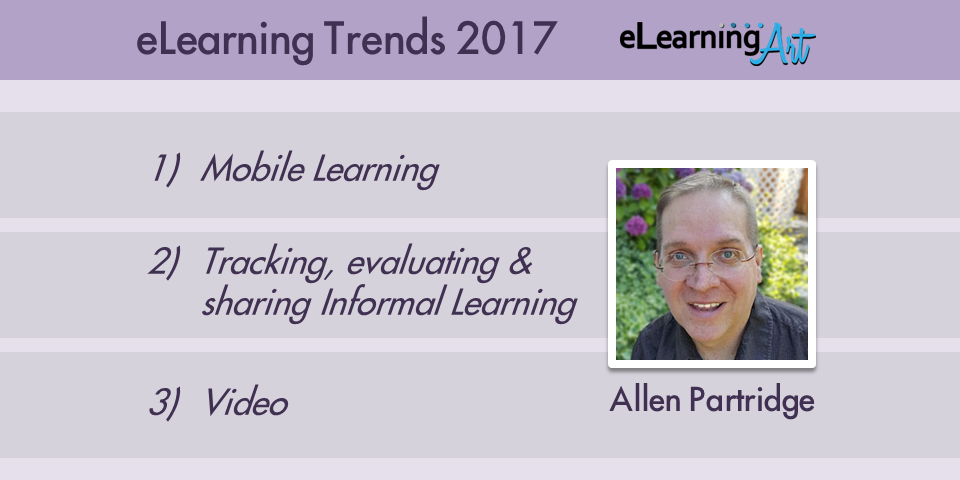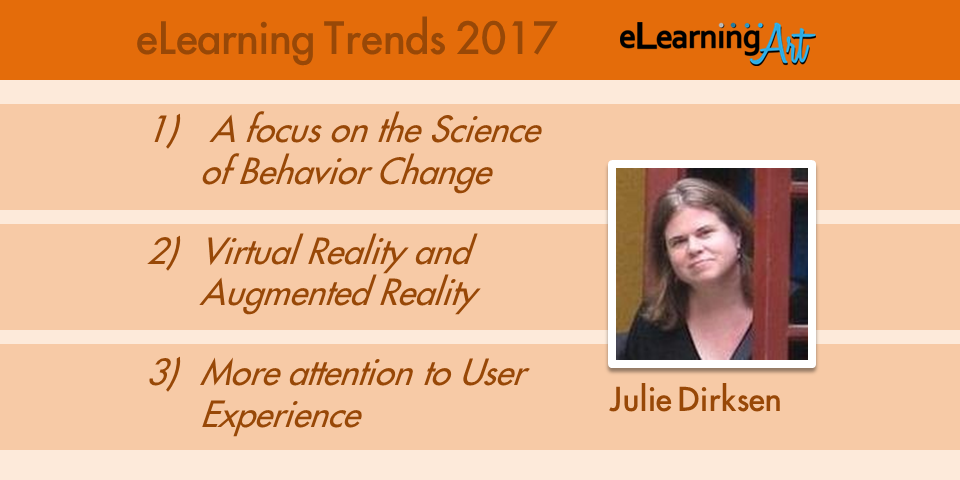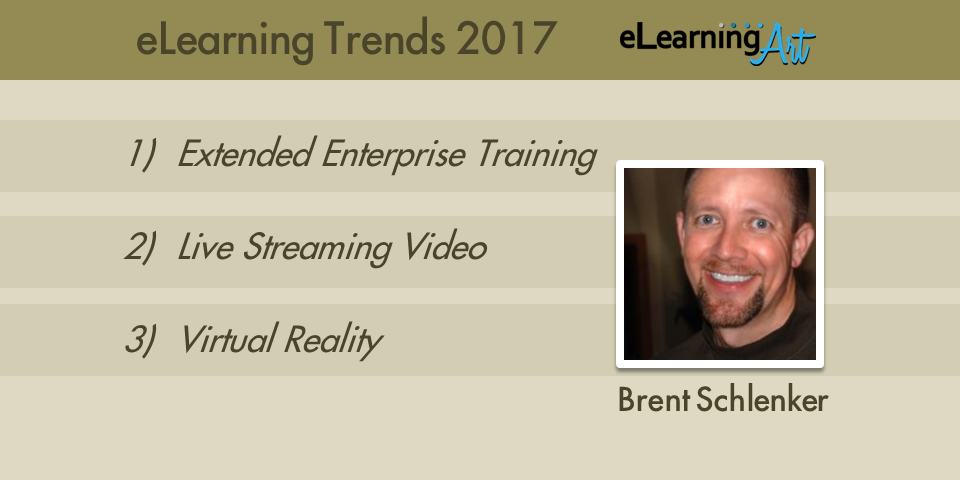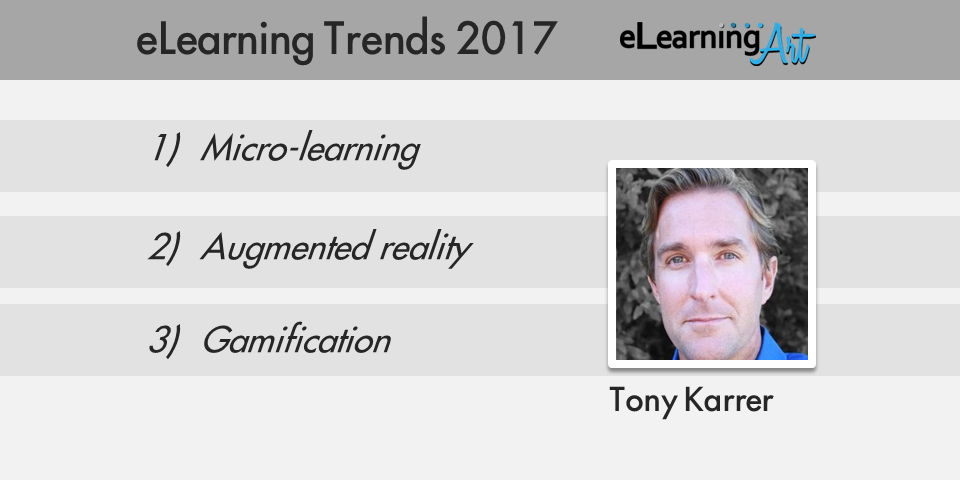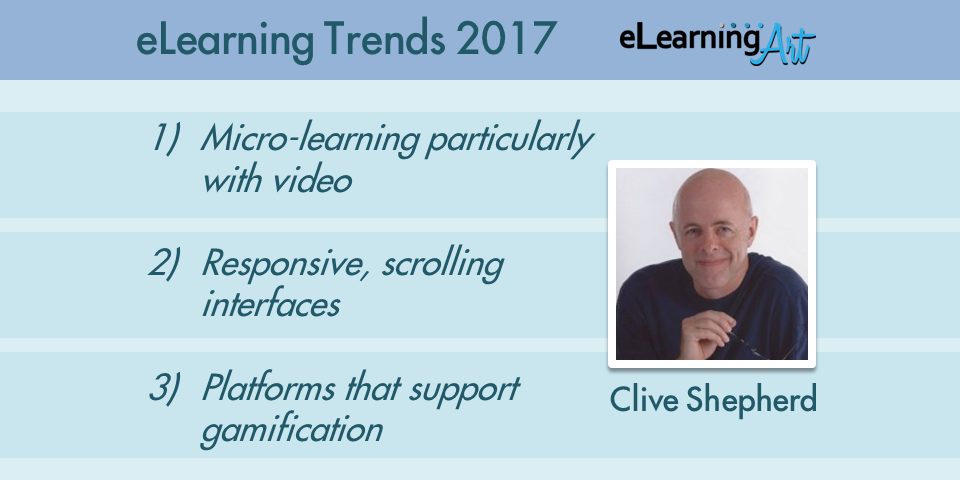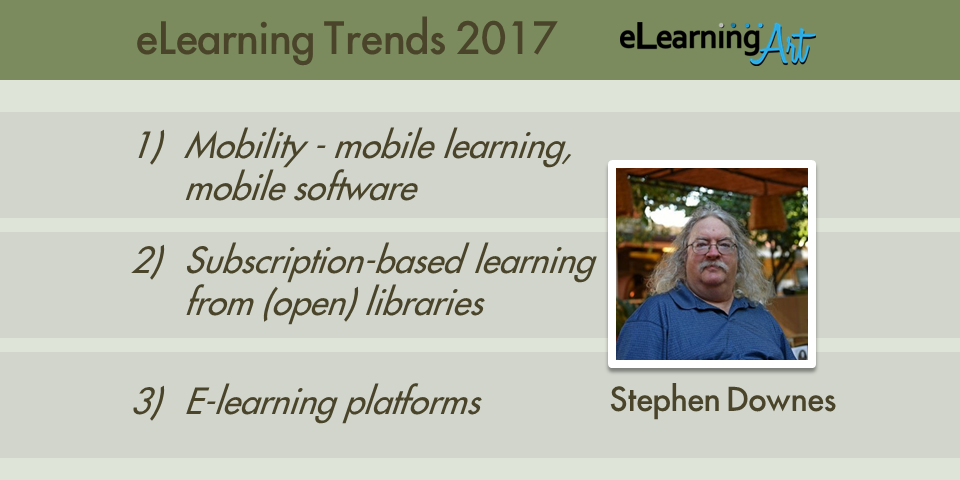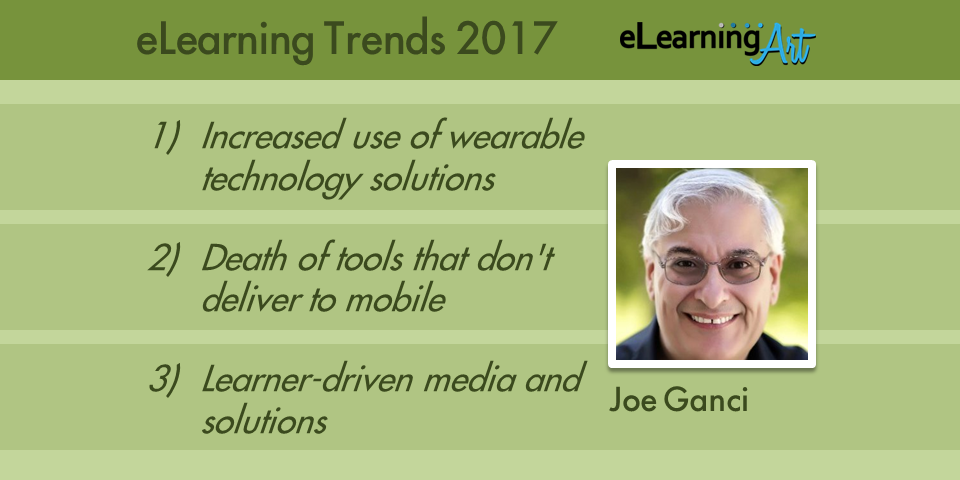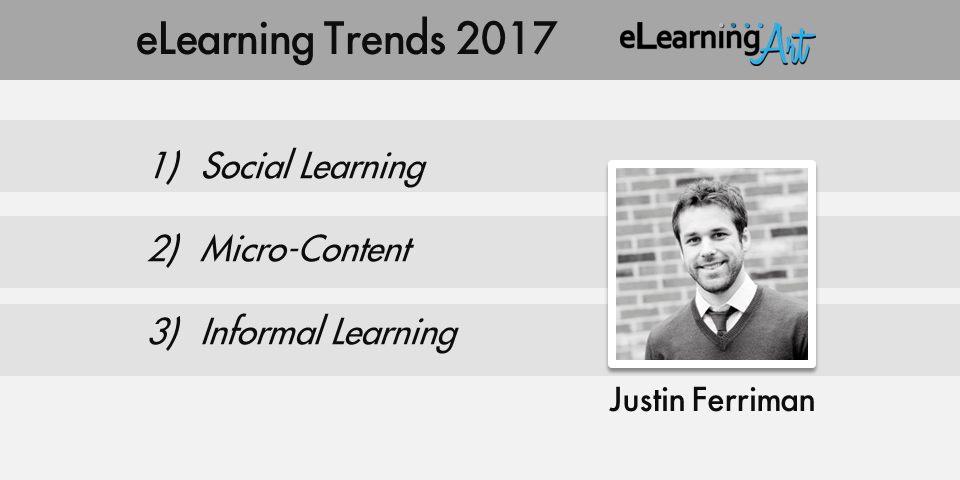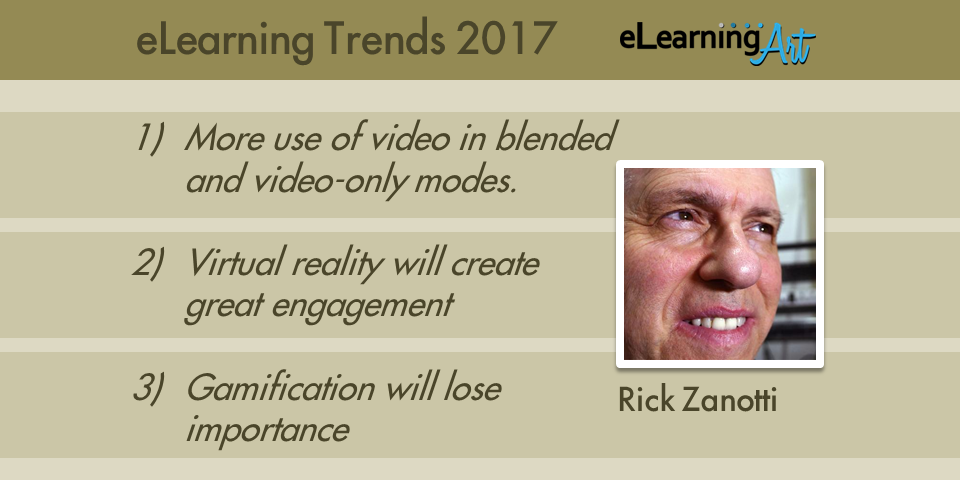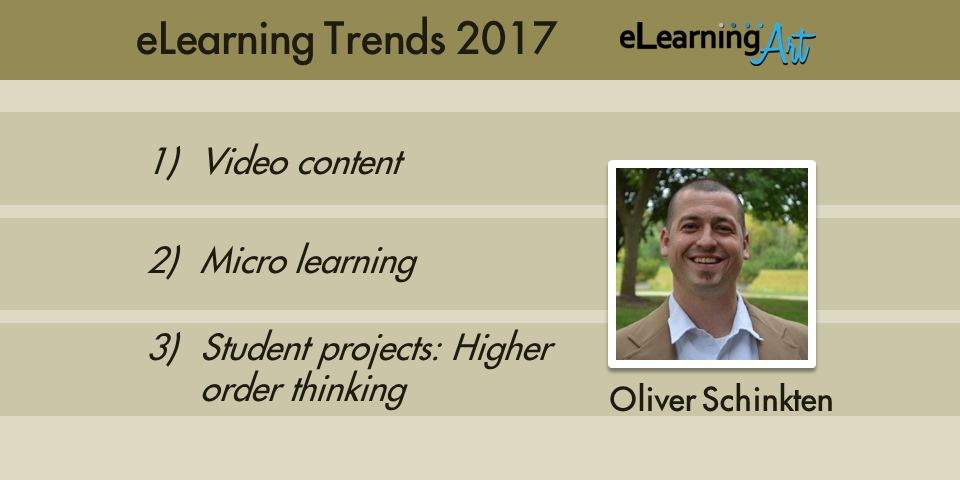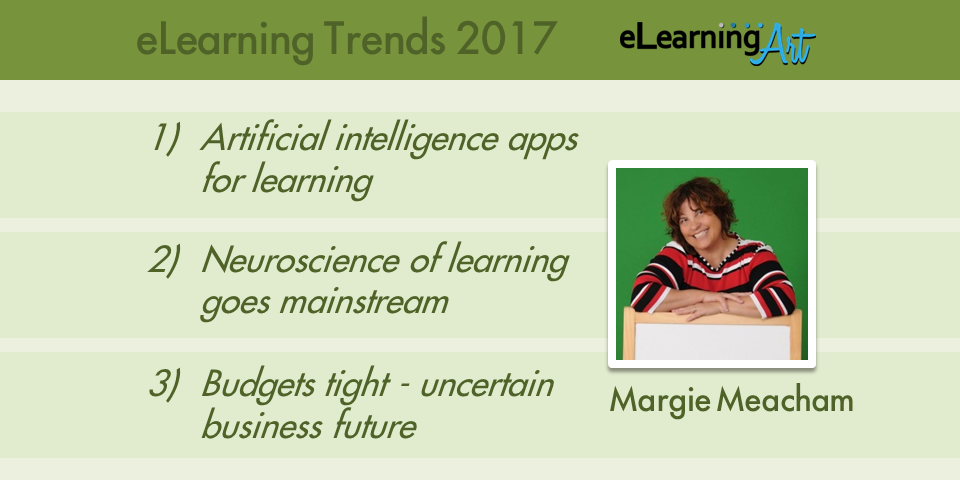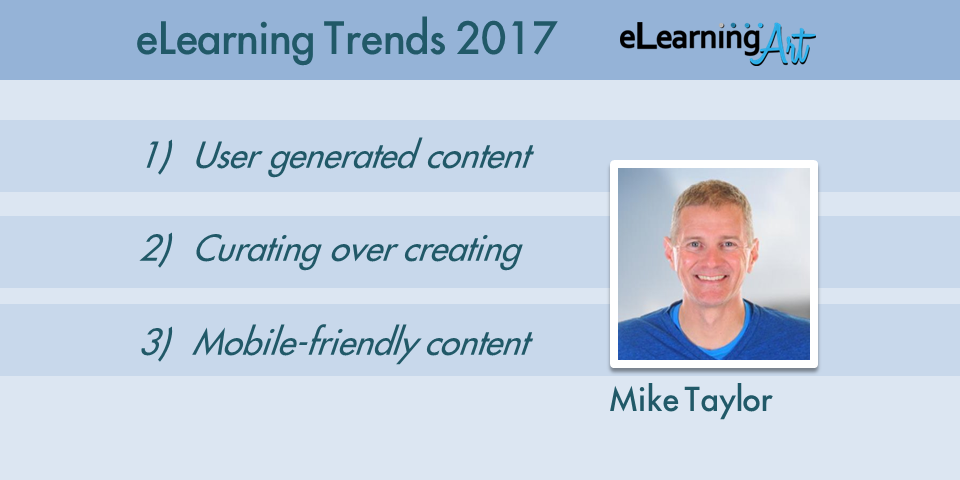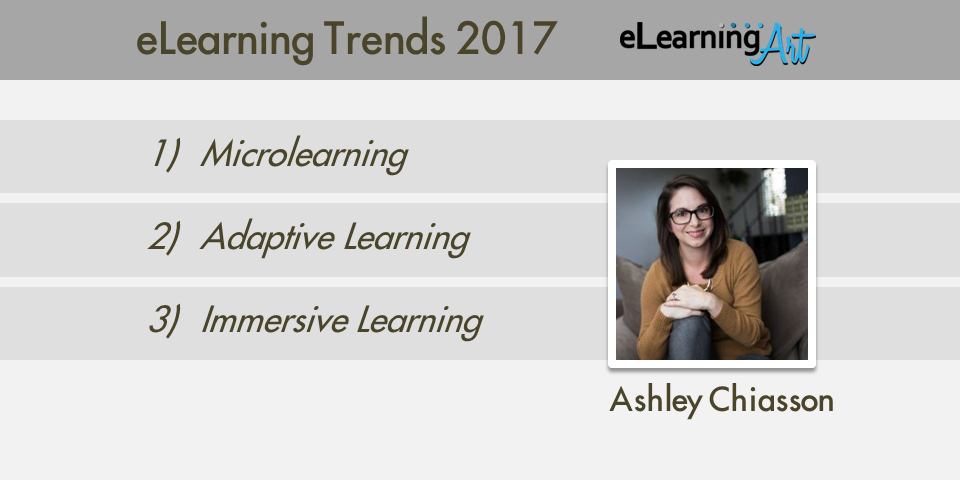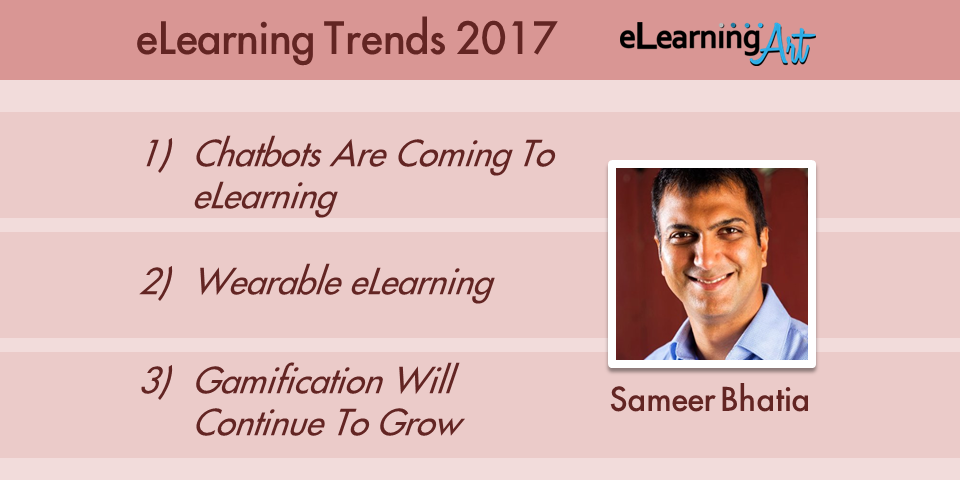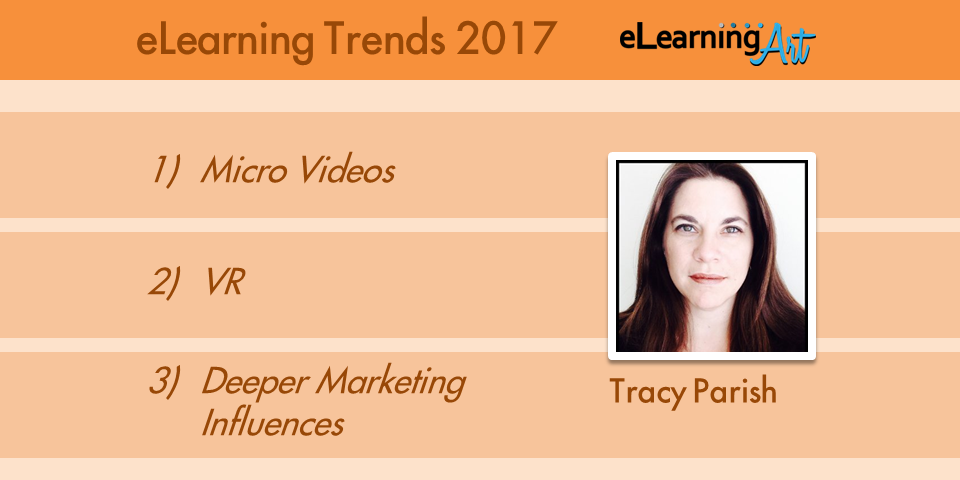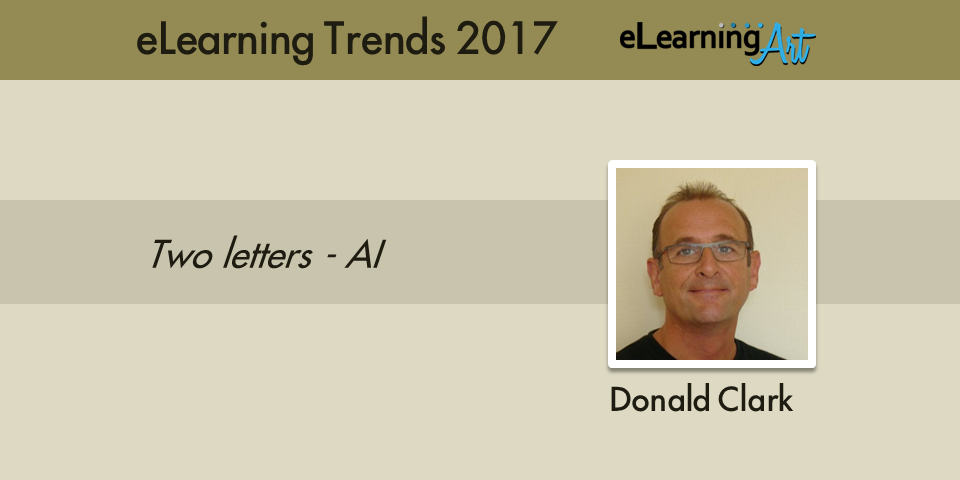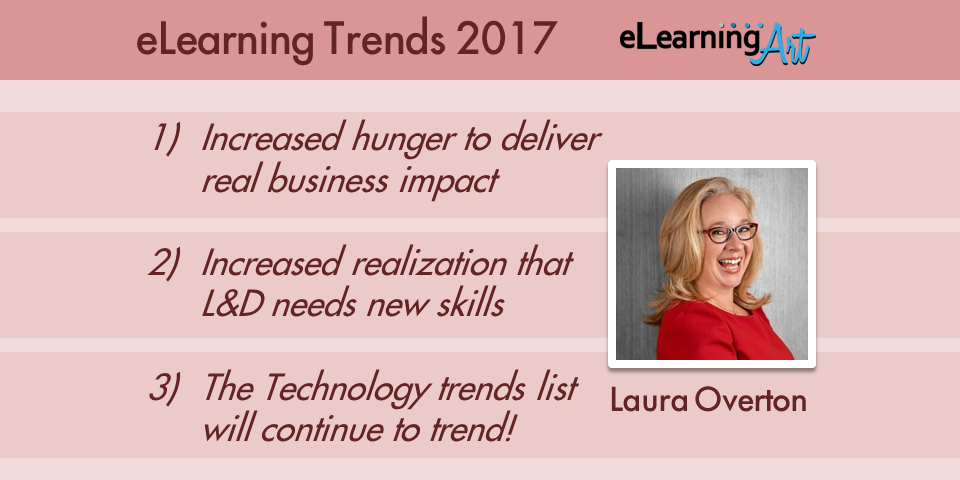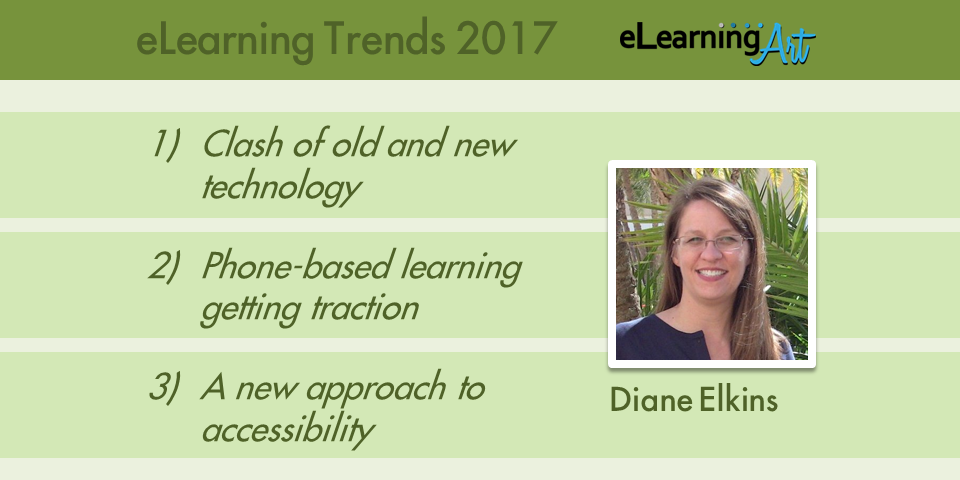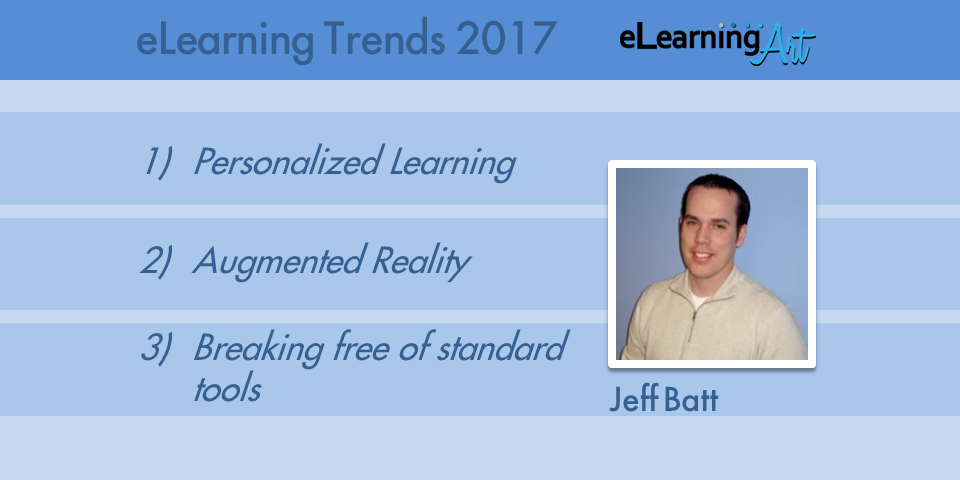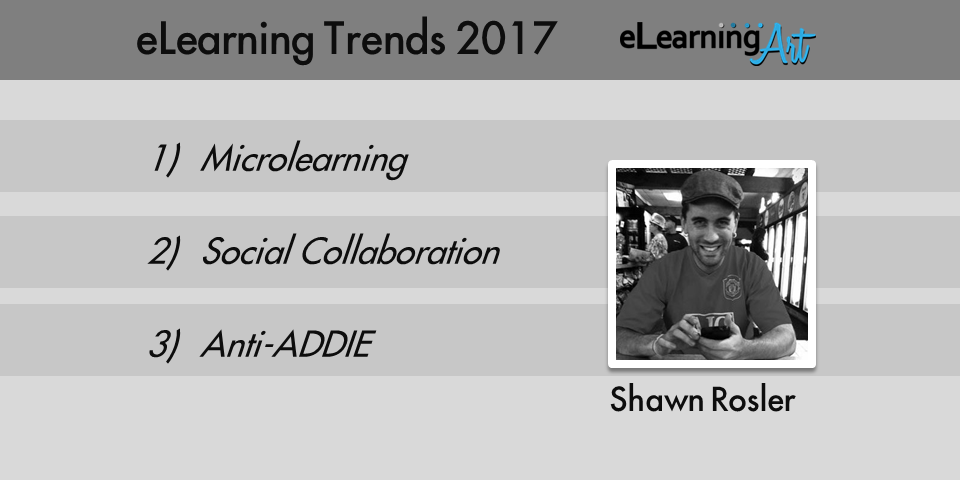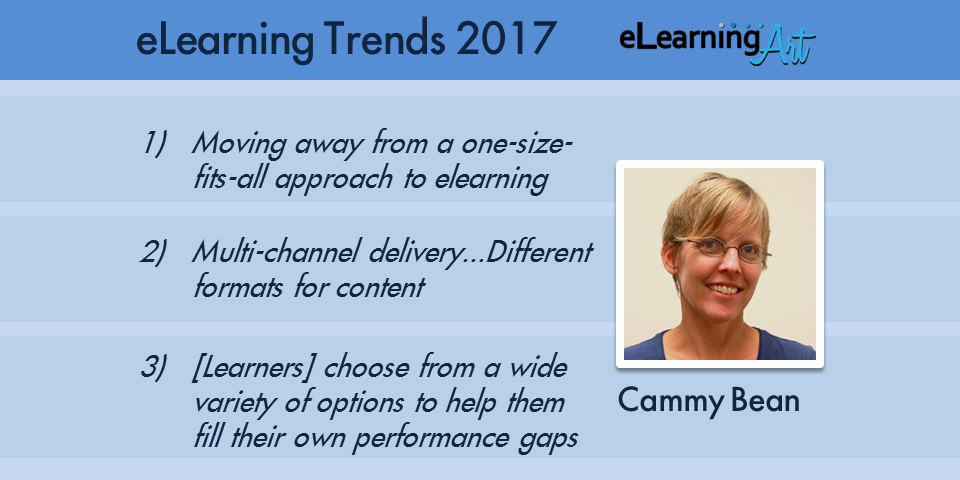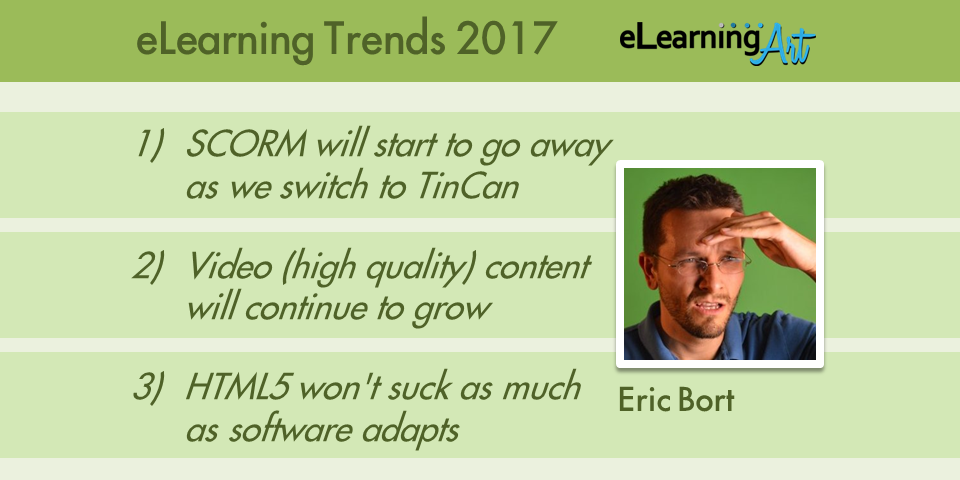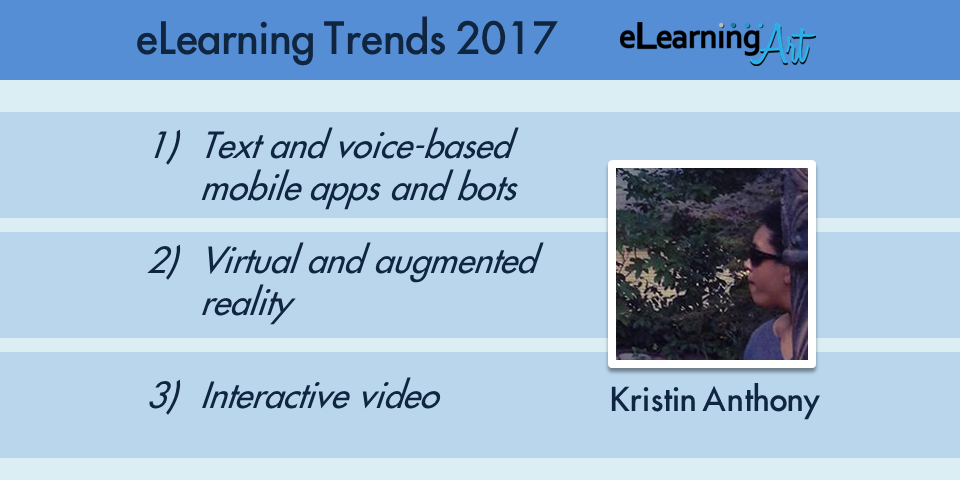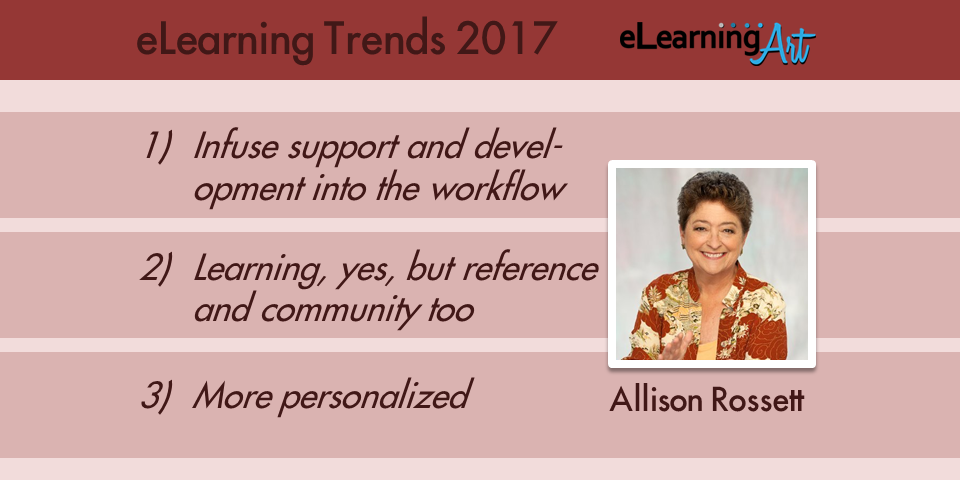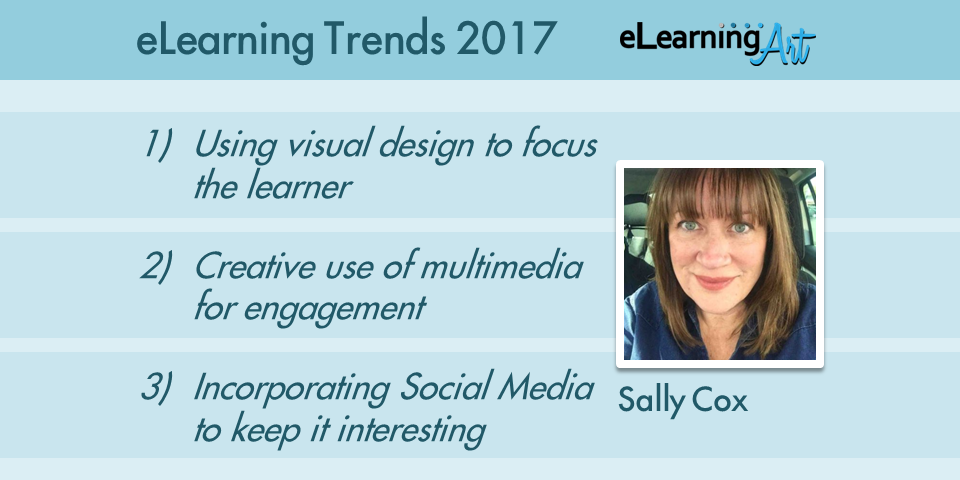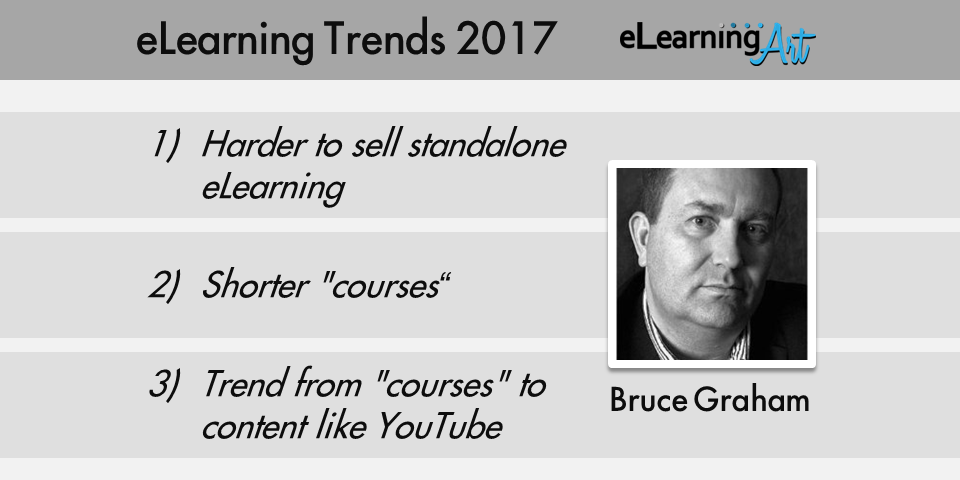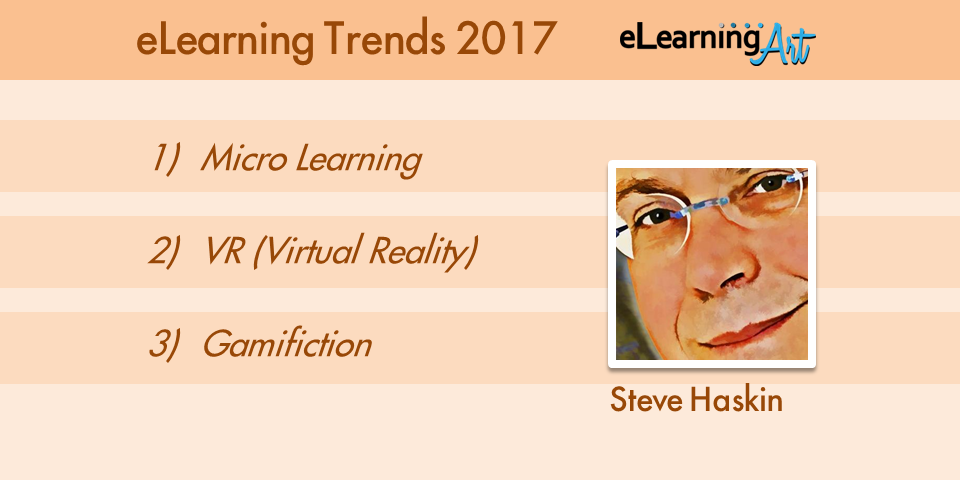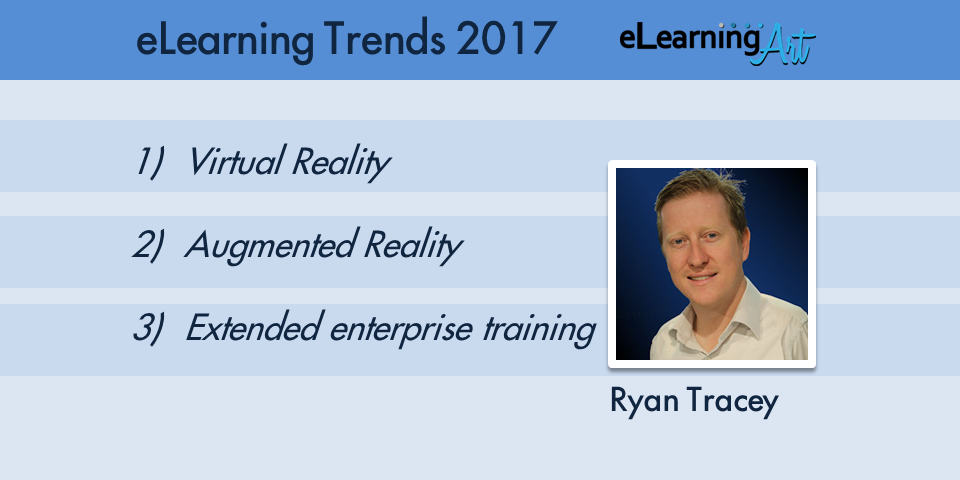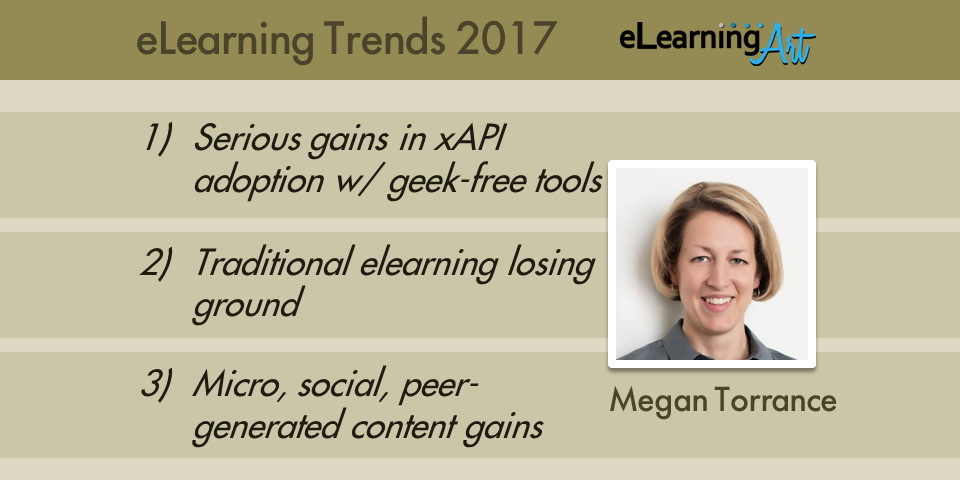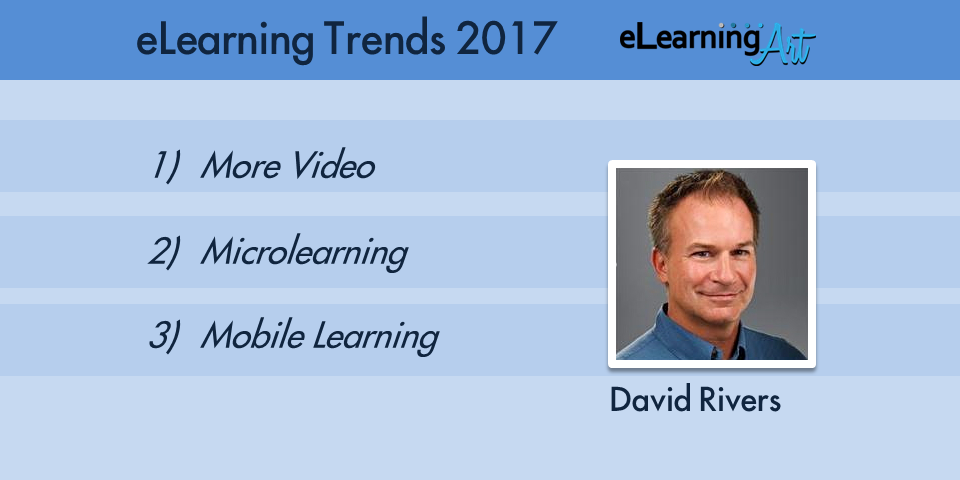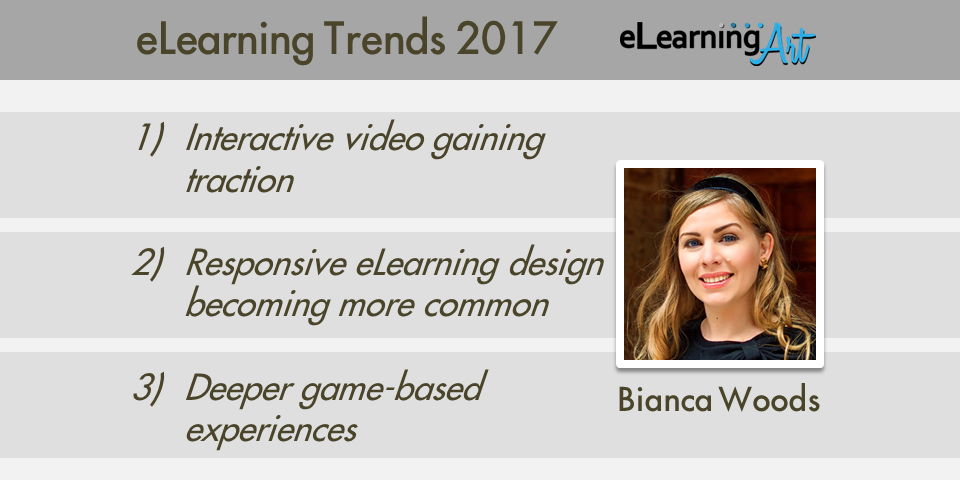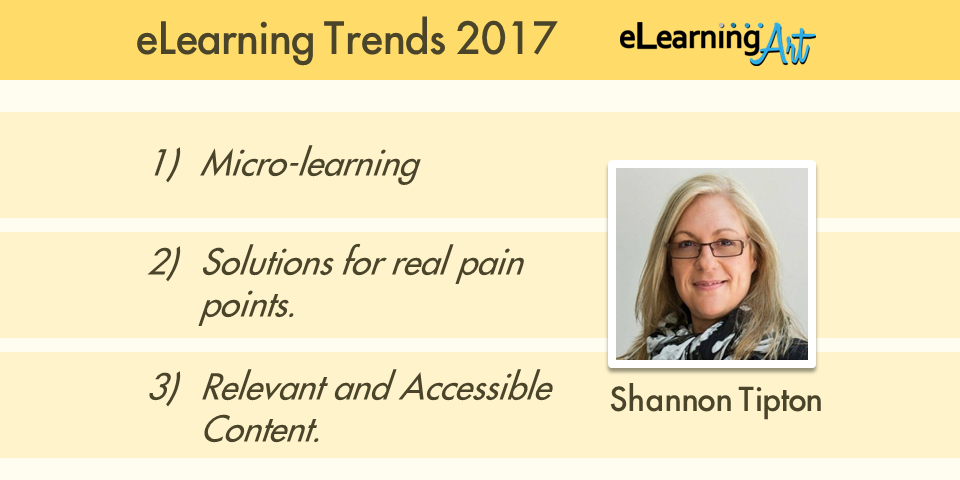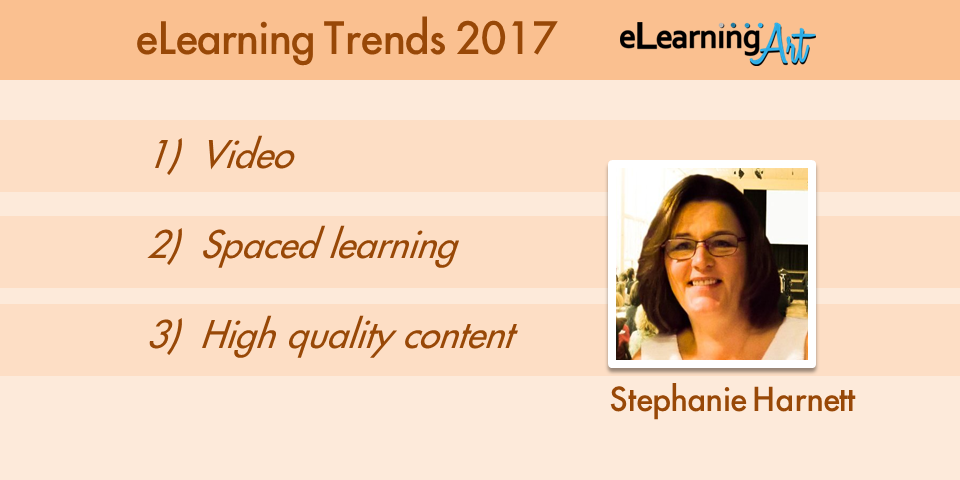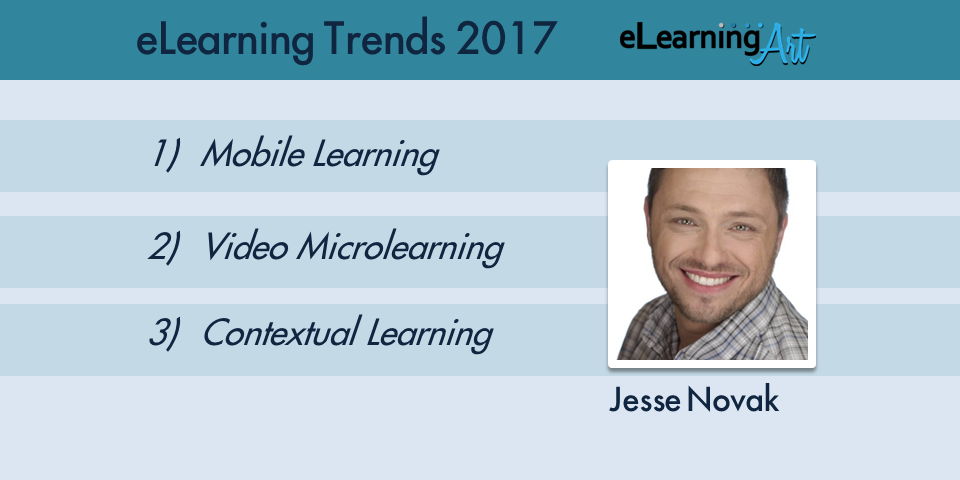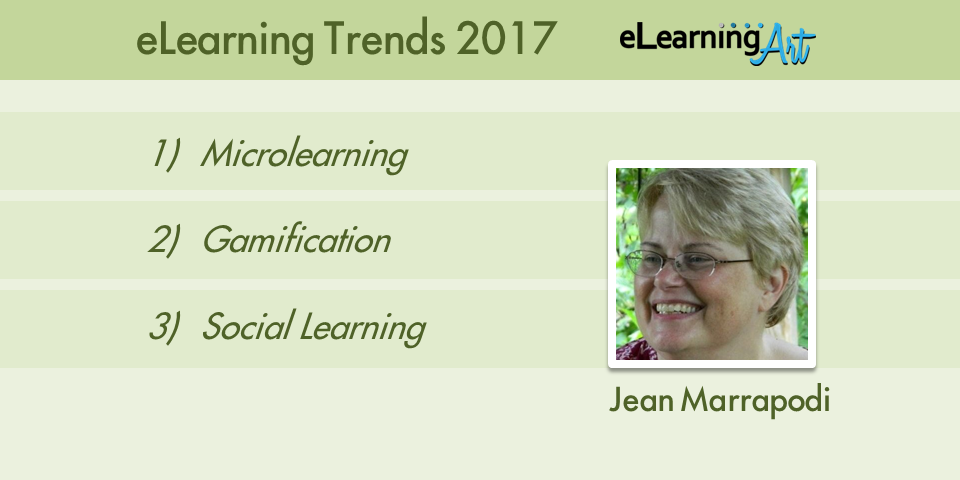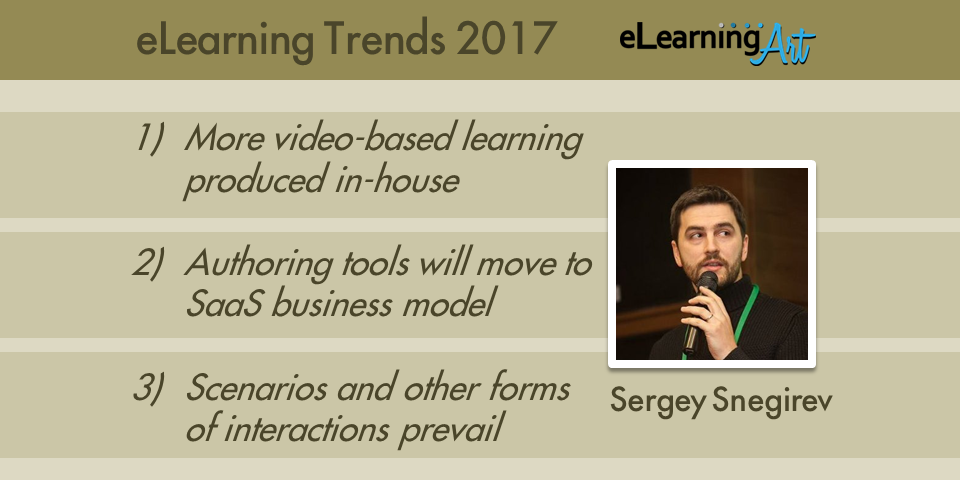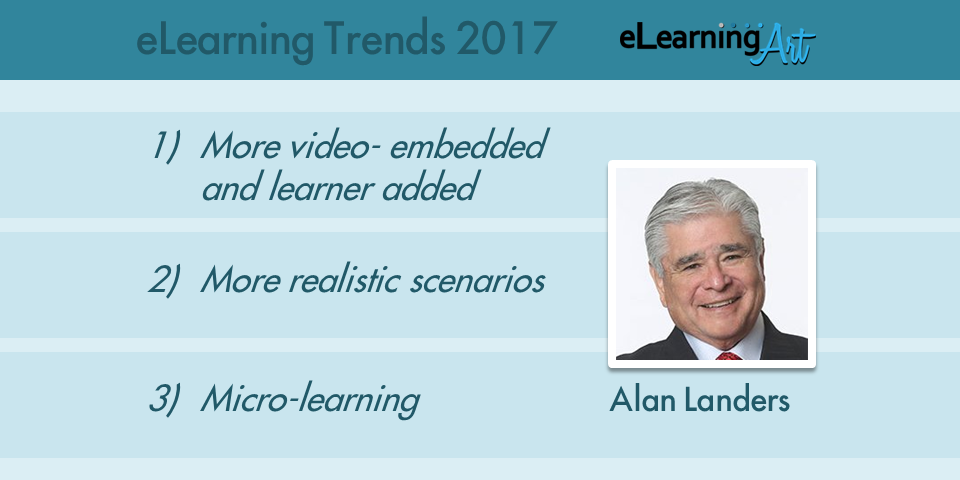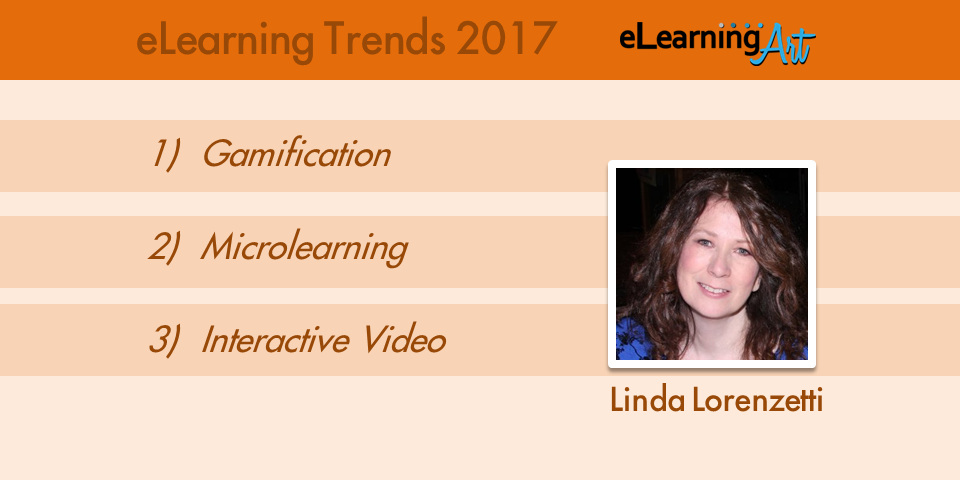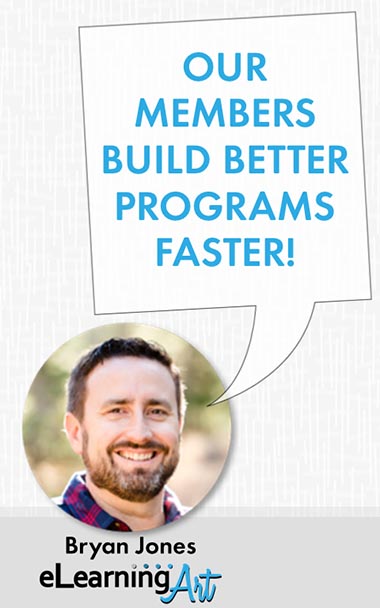Archive of 2017 eLearning Trends
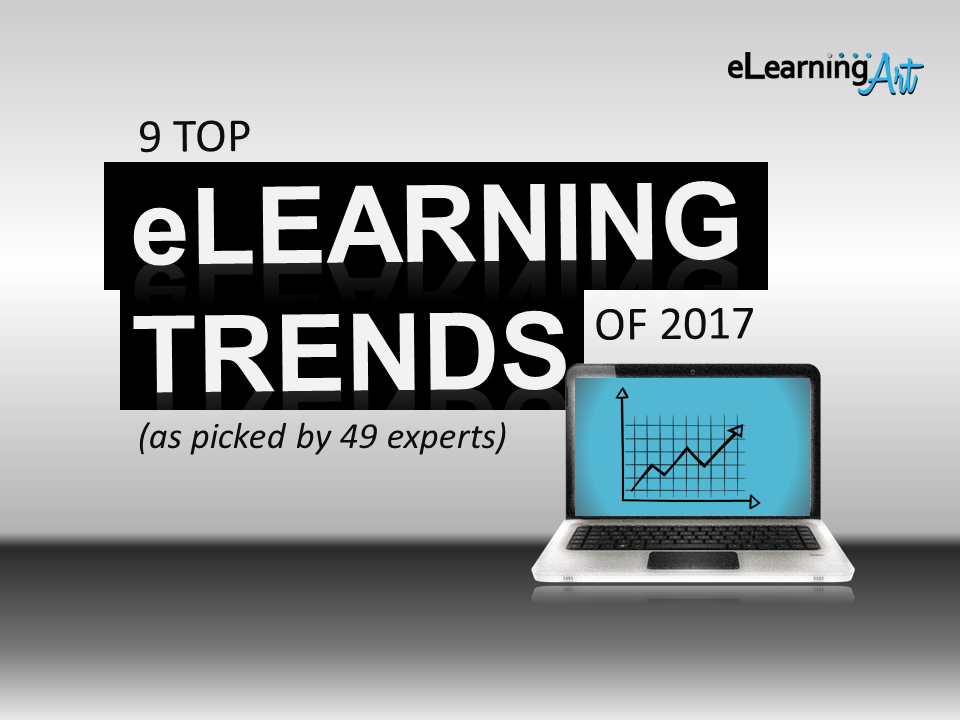
Where do you even start?
I think a good place is by asking 49 of the world’s leading eLearning experts the top 3 trends they predict for 2017.
So that’s just what I did.
Here are the two most interesting takeaways from surveying 49 eLearning experts:
- Trend of Trends: 9 trends were picked by 10% or more of the experts. See the infographic below.
- Expert commentary reveals insights: In addition to their 3 votes, each expert included commentary on why they picked the trends. There are a lot of amazing nuggets in the details, all of which is included below in the detailed interviews..
Beyond the Infographic
The infographic above does a nice job of summarizing the trends.
But the real value is in the detailed commentary, and the specific responses by each expert below.
[highlight]Download additional analysis and all the commentary in the free 2017 eLearning Learning Trends eBook.[/highlight]
Scroll down or click an experts name to see their response.
Michael Allen | Connie Malamed | Allen Partridge | Julie Dirksen | Brent Schlenker
Tony Karrer | Clive Shepherd | Stephen Downes | Will Thalheimer | Joe Ganci
Justin Ferriman | Rick Zanotti | Phil Mayor | Oliver Schinkten | Margie Meacham
Mike Taylor | Lesley Price | Ashley Chiasson | Sameer Bhatia | Tracy Parish
Donald Clark | Laura Overton | Diane Elkins | Jeff Batt | Shawn Rosler
Cammy Bean | Eric Bort | Aaron Quigley | Kristin Anthony | Karl Richter
Allison Rossett | Brian Allen | Sally Cox | Bruce Graham | Steve Haskin
Ryan Tracey | Megan Torrance | Dave Richards | David Rivers | Bianca Woods
Shannon Tipton | Stephanie Harnett | Jesse Novak | Jean Marrapodi | Renaldo Lawrence
Sergey Snegirev | Holly MacDonald | Alan Landers | Linda Lorenzetti |
Michael Allen
After a survey with my marketing, sales, and custom training services teams, I can identify what were most frequently identified as 2017 trends. I hasten to say that there are other avenues we wish were getting attention, but we realize the following trends have practical priorities for the majority of our clients:
Micro Learning — Short learning segments have multiple advantages, but what stands out is their facilitation of getting to specifically needed content very quickly. Microlearning is less about short attention spans than it is making sure that every minute in learning is productive and useful. Small segments lean heavily on good navigation and content curation.
Mobile Delivery — Coupled closely with micro learning, because nobody enjoys long sessions, especially on small devices, mobile micro learning allows taking advantage of short breaks in the day to learn. Although when it’s time to perform, it’s too late to learn and practice, a quick rehearsal or brush up on critical points or steps in a procedure can be very helpful. We see a trend to design and deliver training apps for smaller, mobile devices as a compliment to primary learning activities.
Gameful Design — This ranges from gamification to serious learning games. In our work, we’ve noted that the primary components of context, challenge, activity, and feedback (CCAF) are also primary components of successful, interactive games. So contrary to common beliefs, development of serious learning games is not a big leap from developing excellent e‑learning. Both can deliver the essential meaningful, memorable, and motivational learning activities, but all learning applications can benefit from some elements of gameful design.
The trends listed above are what we expect to see become mainstream strategies. There are really no surprises there. What may be more interesting is new directions that will become future trends, whether sooner or later. Those future trends include Spontaneous Learning Systems (SLS), Intelligent Mentoring Systems (IMS), and highly personalized learning services. Also, in some way or other, Virtual Reality and Augmented Reality systems will surely find applicability in some sectors.
Michael Allen is the CEO of Allen Interactions. He has been a pioneer in the e-Learning industry since 1975. He’s well known for his books, thought leadership, and conference speaking engagements. He holds M.A. and Ph.D. degrees in educational psychology. You can learn more about Michael here.
Connie Malamed
Learning via technology is anything but novel. The Internet is overflowing with instructional content and information presentation. Because there is so much choice, people are learning to block out the superfluous, the irrelevant and the mediocre.
For our industry to stand above the noise, we need to think of ourselves as service providers. And our service is to understand what individuals and groups need and to provide it in an appealing and original way.
It may involve empowering others so they have the tools and abilities to learn on their own. It may be creating beautiful experiences that are easy to use and that provide speedy answers. Or it might be opportunities to explore, discover, play and practice.
We all know that trends don’t happen anew on January 1st. But movements build and gain momentum. I think the desire to try something new, to care about aesthetics and usability, and to become relevant to the workforce (again) are evolving standards in our field. I think these principles will continue to develop and grow.
Connie, known online as the “eLearning Coach,” is the author of Visual Design Solutions, a top rated eLearning design book. She has also been consulting independently for nearly two decades, with a focus on online learning, visual and information strategies and design. Learn more about Connie here.
Allen Partridge
Mobile, especially mobile content that changes dynamically to fit the size and orientation of the screen, and takes advantage of mobile capabilities will lead the pack with emphasis on micro-learning on mobile for smart phones.
Google first has become the mainstay of research for business pros and we’ll see a rise in solutions that support auditing, rating and sharing relevant professional resources within organizations that aligns with social and user generated content offerings.
Video remains the strongest long term trend. Expect continued improvements in the ease of getting streaming video content to learners, and improvements in delivering both standard and interactive video.
Dr. Partridge is an eLearning Evangelist for Adobe Systems. He has served on the Doctoral faculty of The University of Georgia & Indiana University of Pennsylvania, and taught education and the arts in Universities for more than 20 years. He has spoken to groups around the world about education and eLearning. Learn more about Allen and Adobe.
Julie Dirksen
These may be wishful thinking on my part — it might be more accurate to say that these are the trends I’d like to see.
Julie is a well known eLearning author and speaker. She is a Learning Strategy Consultant for Usable Learning. She also holds an MS in Instructional System Technology. Julie’s book, Design for How People Learn, is a must read for every instructional designer. Learn more about Julie here.
Brent Schlenker
In 2016 we saw each of these trends take root. In 2017 they will continue to grow as vendors begin to support the new trends more heavily. Many businesses are seeing the benefits of training the extended enterprise and looking for opportunities to shift their training departments from a cost center to generating revenue. Live mobile streaming video will continue to grow and integrate with communication, collaboration, and learning strategies. The movement towards VR is very real and will push into the training departments faster than many are anticipating.
Brent is the Chief Learning Strategist for Litmos and a recognized eLearning industry leader. He was well known as the Program Director of the eLearning Guild before taking senior leadership roles in the corporate sector. He also hosts the L&D Talk Youtube channel and is a popular blogger. Learn more about Brent here.
Tony Karrer
At eLearning Learning, we track what top thought leaders are saying on many topics. The top eLearning Trends 2017 being discussed are micro-learning, augmented reality, analytics, gamification and mobile learning.
Tony is best known in the eLearning industry for founding eLearning Learning, which pulls in blog posts from the most popular eLearning bloggers.
Clive Shepherd
It is interesting to see how our experience of digital content in our home lives is now being echoed when we get to work. We may finally be seeing the end of the slide metaphor for e-learning content and the desktop tools that go along with this, although nothing moves quickly in corporate training.
Clive is the Founding Director at The More Than Blended Learning Company. He is a recognized thought leader and author in the eLearning space with over 30 years of experience in technology-assisted learning and communications. You can read more about Clive on his blog.
Stephen Downes
These are core trends, not fads like VR or blockchain. They reflect both the demand for wider (and cheaper) access, plus the rise of new distributed technologies that make it possible. The crucial (but non-sexy) word for 2017 is “provisioning”.
Stephen is a Researcher, Learning and Performance Support for the National Research Council Canada. He’s one of the originators of MOOC and is well known in the industry for his OLDaily newsletter, which I’ve been subscribed to since 2009. Learn more about Stephen here.
Will Thalheimer
The learning market is becoming a learning-technology market going crazy with disruptive new companies and products. This hurts established players who are freaking out trying to find new ways to reach customers. Biggest good trend is more and better tools for subscription-learning (threaded-microlearning) utilizing research on spacing. Biggest hidden trend: more companies are doing research on their own products! Also, more organizations are opting out of their traditional learner-feedback forms and opting into performance-focused smile sheets (disclosure: of which I am the creator). Backlashes arising for poor uses of microlearning, gamification, neuroscience. Finally, too much crappy information in content marketing.
Will is a Learning and Performance Consultant and Researcher, and the author of the popular book, Performance Focused Smile Sheets. He is a frequent speaker and workshop leader and known as a thought leader in the eLearning industry. Learn more about Will here.
Joe Ganci
As costs decrease, technology such as augmented reality, 360° video, NFC tags and more will be available for those content areas where they make sense.
eLearning tool vendors that still don’t allow publishing for mobile devices will find themselves with ever-smaller market shares.
Learners will be able to contribute video recordings and other media from their mobile phones to community learning sites. Social networks will allow them to help one another more and more.
“eLearning Joe,” as he’s known in the industry, is a frequent keynote and conference speaker, an author, teacher, and consultant. He’s the owner of eLearning Joe, where he both builds custom eLearning solutions and teaches clients and students using a hands-on style. Learn more about Joe.
Justin Ferriman
Mobile is the growth driver in e-learning and many of the trends will stem from it. Social learning concepts, micro-content, and informal learning are a result of the mobile learning surge. Expect ‘snappy’, concise courses that leverage the social components that we are used to but outside of the formal e-learning context.
Justin is the founder of LearnDash, an LMS built on WordPress. He’s also the author of the popular Learning & Collaboration blog. Learn more about Justin and his company here.
Rick Zanotti
Businesses will not invest in a trend that doesn’t prove a profit or tangible results.
Rick is the President of Relate Corporation, an e-Learning and Training company. He also hosts the popular eLearnChat video series, where he has interviewed over 100 eLearning experts. You can learn more about Rick here.
Phil Mayor
We are moving into a world where companies want just in time learning, they want employees to be able to learn what they want when they want. To do this Microlearning becomes the ideal solution and mobile via responsive learning becomes the ideal vehicle.
Phil is the Creative Director of Elearning Laboratory. He is an Articulate Super Hero and award-winning eLearning developer. Learn more about Phil and his company here.
Oliver Schinkten
As technology and apps continue to improve I believe we’ll continue to see more and more video content being utilized in eLearning environments. There will also be more opportunities to engage students in projects, with an emphasis on higher order thinking skills, including the creation of videos, podcasts, blogs and more. The use of mobile devices for learning will continue to rise as the number of people with mobile devices increases, along with the increased emphasis on optimizing websites and applications to accommodate mobile users. Peer feedback, social learning, and personalized learning should also gain momentum.
Oliver is a Staff Author, Education & eLearning for LinkedIn and Lynda.com. He’s also a frequent speaker and author. His mission is to help provide content, professional development and opportunities for anyone who wants to empower themselves through learning. Learn more about Oliver here.
Margie Meacham
It’s no accident that neuroscience and AI are my top two trends, since they are interconnected. While we have been seeing both topics pop up here and there for years, 2017 will be the year they become part of the day to day conversation instead of just promising curiosities.
Margie is the Chief Freedom Officer of Learningtogo. She’s the “brain lady” and brings her insights from the neurosciences to enhance learning and performance. She’s also the author of popular book, Brain Matters: How to help anyone learn anything using neuroscience. Learn more about Margie and her company here.
Mike Taylor
As the pace of our world accelerates, organizations need to move from delivering training to a new mindset of driving people towards proficiency more quickly. Frequently, this means doing more with less. The most effective among us are moving beyond creating traditional courses to more efficient options like curating existing content instead of recreating the wheel. Increasingly, the best content is created by people outside the training department. And while we still have a way to go, most content creation tools are at least moving towards a mobile-first view of the world.
Mike is a learning technologist at Mindset Digital, as well as a former Community Manager at Articulate. He is also a frequent eLearning conference presenter and expert eLearning blogger. You can learn more about Mike on his blog.
Lesley Price
I have a big problem with L&D following ‘trends’. IMHO one of the big problems with L&D is that all too often we follow trends rather than focusing on workplace learning that improves both individual and business performance.
Generally spending so much time and energy on trends results in a focus on the minutiae rather than on the bigger picture. In my experience its the combination of lots of relevant and appropriate learning interventions that keep the bigger picture in mind which will lead to overall improved business performance and to a better equipped workforce.
Lesley is a Senior Consultant at Learn Appeal and a Facilitator for #chat2lrn on Twitter. She specializes in analyzing complex situations and designing, implementing, and managing programs from a local to national scale. Follow Lesley on Twitter here.
Ashley Chiasson
I’m predicting…a lot of different learning. No really NEW trends, but still trends.
1. Microlearning is a hot topic at most e-learning conferences these days, with the whole ‘learner’s attention span is shorter than that of a goldfish’ (despite that being debunked).
2. Adaptive learning and personalizing the learning experience is becoming critical – it’s been done well in few places, but the learning world is demanding more.
3. Immersive learning will continue its reign as an e-learning trend, and technologies (e.g. VR/AR) are becoming more sustainable, so it seems worth keeping an eye on.
Ashley is an author, speaker, instructional designer, and eLearning developer. She has authored several books on Articulate Storyline and well known in the Articulate community for sharing both her insights and her examples. Ashley also blogs frequently about eLearning. Learn more about Ashley here.
Sameer Bhatia
Chatbots are growing in terms of technology and efficiency. When chatbots first came into picture, lack of coherence doubted its future. But now with technology advancement, chatbots are assisting in every field from taking orders to calculating taxes. I believe that chatbots can be seen as future instructors in elearning environment and can start out by answering many of the basic or repetitive questions students have.
The other thing to watch out for in 2017 will be the integration of wearable technology in e-learning. With the evolution of technologies like Google Glass, Smart Watches, and VR headsets, expect advancements in the field of 3D learning, such as virtual workplace simulations and real-time interaction to create an interactive learning experience for users. With the Tin Can Experience API tracking these off-the-desk learning activities would be a breeze.
Also, gamification will continue to grow as a strong strategy towards creating truly engaging and immersive learning. Add mobile devices and augmented reality in the mix, and we have a great opportunity to create high impact learning with games that rewards and engages the learners.
Sameer is the Founder and CEO of ProProfs, where he has built the company into one of the most popular online platforms for building and testing knowledge. Sameer is a good friend (was a groomsman in my wedding) and an all around good guy. I’m also a proud user of several of his company’s products. Learn more about Sameer here.
Tracy Parish
It’s hard not to imagine how micro videos (60 secs or less) are not going to impact learning. It’s predicted that 70% of mobile traffic by 2021 will be video. I can see these short videos becoming key components to performance support, quickly engaging learners into content, and a variety of other uses. That leads to the idea of marketing influences greatly impacting the way we deliver content. I’m seeing more and more training content being created that mirrors layouts deliver similar to major marketing campaigns and product information for consumers.
Tracy is an Education Technology Specialist at Southlake Regional Health Centre. She’s well known in the Articulate community as a designated “hero.” Learn more about Tracy here.
Donald Clark
Two letters – AI. Artificial Intelligence has been around in learning for a long time with Google, easily the most important pedagogic shift in the last 20 years.It is now the invisble hand behind socia. media and there are tools such as WildFire that create content at a fraction of the cost of traditional onine learning, curate content, give personalised learning and adaptive feedback. Then there’s consolidation and assessment. AI is easily the most important technology trend on the planet, to imagine it will not affect the learning world is bizarre – it already has.
Donald is the CEO of WildFire Learning, a frequent conference speaker, eLearning blogger, and thought leader. Learn more about Donald here.
Laura Overton
The Towards Maturity Benchmark for L&D leaders around the globe has been running since 2003. We continue to see a clear upward trend in the hunger of today’s learning professionals to not only deliver more for less, but to improve performance, increase agility and influence culture – this will only increase in 2017.
Unfortunately, we have also seen a downward trend on those delivering against their aspirations – this has to stop! The performance gap is worrying and demoralizing for a profession that has both the aspiration and opportunity to unlock potential in their organisation and the individuals around them.
Moving forward, there is one trend I would like to see less of: our increasing preoccupation with technology trends! The slavish reliance on finding the next ‘silver bullet technology’ to cure our woes and deliver our dreams has to stop. Our benchmark research shows that it is not the tools we use, but how we use them that makes an impact on the business results we hunger for. What ought to be trending in 2017 is the realization that learning professionals need to develop new skills and new mindsets to embrace the changes ahead!
Laura is the CEO and Founder of Towards Maturity, where she focuses on providing in-depth research and resources for effective learning innovation in the workplace, including the 2016-17 Learning Benchmark Report, Unlocking Potential. She’s also a fellow SmartForce alumnus! Learn more about Laura here.
Diane Elkins
1. Design and technical decisions are getting tough as many of us have one foot stuck in one world wanting newer technology for newer devices and one foot stuck in another world where we still have to support older technology (such as IE9 that doesn’t support HTML5). 2. People have been talking about training on phones for years. We are starting to see more and more business cases where there is a compelling business reason for phone compatibility (more than just “people like it.” 3. The Federal government will be releasing new accessibility standards very soon.
Diane is the Owner of Artisan E-Learning. She is an award winning designer and a frequent speaker at eLearning conference. She is also the author of multiple eLearning books. You can read more about Diane on the Artisan blog.
Jeff Batt
Without going into depth too much I think we are going to see the need to personalize our learning to our students. xAPI allows to use to create suggested learning content just like Amazon would recommend other products to its customers and tailor our learning to meet the students needs. In order to do this we must break out of standard PPT like tools to get our learning into native apps, custom websites and my final trend prediction which is augmented reality. I see augmented reality as the ultimate on the job performance aid, imagine starting a new job and walking through the office and getting several job tips and tricks you can use in the moment. To get learning into all these new areas we have to broaden the kind of development we do and the kind of developers we work with.
Jeff is the eLearning Development Lead at the LDS Church & Founder of LearningDojo.net. He has over a decade of experience building eLearning and multimedia solutions and shares his insights through his Pluralsight courses. Learn more about Jeff and his company here.
Shawn Rosler
Well I could certainly go into why each of the items listed above is significant, I think the trend we’re looking at across all three items is that time and money are both short. We now, learning wise, need to maximize efforts based on both factors. Micro learning allows more bite-size knowledge transfer, social allows collaborative learning while completing work, and eliminating ADDIE gets learning out to the masses quicker.
Shawn is the Leard EHR Analyst, Instructional Designer, and Trainer at Geisinger Health Systems. He holds both a B.S. of Education/English and an M.S. of Instructional Technologies from Bloomsburg University. He’s a frequent eLearning blogger and recently was a docent for the DevLearn eLearning conference. Learn more about Shawn here.
Cammy Bean
With all the new and cool tools out there, I see an emerging and welcome trend in moving away from a one-size-fits-all approach to elearning. Instead of people just building one elearning module to rule them all, we see more organizations moving to multi-channel delivery. That is, different formats for content — some video, some courses, some activities, etc. And the expectation isn’t that every person will access every single content asset, but will rather choose from a wide variety of options to help them fill their own performance gaps. More choices = win!
Cammy is the Vice President of Learning Design at Kineo. Her popular book, The Accidental Instructional Designer, is a must-read for all instructional designers. She’s also a frequent speaker at eLearning conferences and frequently blogs on her own blog, Learning Visions.
Eric Bort
Training is an organic market and like anything, follows trends and outside pressure. Employees set the expectation on what format content they like to digest which can lead to changes in production style & approach.
Eric is an award-winning eLearning developer and the President of Clearly Trained. His projects have reached massive scale, being viewed by over 100 million unique users. If you’re looking for design inspiration or need some help with your custom development, check him out over at Clearly Trained.
Aaron Quigley
A major theme this year in eLearning will be parody with new technology. Historically, eLearning is behind the time for tech adoption – a late adopter of flash, slow to accept HTLM5, and responsive design has only emerged for Captivate and Articulate in the past few years. In 2017, eLearning creators will help lead the charge for new technology as we continue to make training device agnostic, and push the envelope for adapting VR and AR as training platforms. Elearning will be the first non-game-based, but widely accepted, use of VR.
Aaron is the Content Manager, Education & Instructional design at LinkedIn Learning. He helps teachers and trainers rock at their jobs. Learn more about Aaron here.
Kristin Anthony
I think 2017 and beyond will be an opportunity to learn a lot more about designing for new interfaces. Virtual and augmented reality are already hot topics in L&D circles. Similarly, interactive HTML5 video has also been a buzz topic. However, I think we should also be thinking about non-visual interfaces like text and voice and how and what to design for situations where graphical user interfaces are not the norm. I think 2017 will be a year to explore the larger device ecosystem and how to design experiences that work across or extend between these devices.
Kristin Anthony is an Instructional Designer at Planview. She frequently shares her thoughts and examples on her blog and is the host of the “Dear Instructional Designer” Podcast. Learn more about Kristin on her website.
Karl Richter
Will this be the year that Tin Can (xAPI) does more than just string us along? Will we be able to harness the potential of reports that go beyond merely attending instructor led training or completing a SCORM module?
If so, we’ll build courses knowing we can run reports on learner’s activity while encouraging them to add their knowledge to the course. Track contributions to forum posts or edits to the corporate wiki. Monitor a learner’s comments on an internal blog. Design a flexible curriculum that can be personalized with bite-sized videos that satisfy the modern learner’s appetite for smaller morsels of information.
Karl is the Owner and Creative Director of Learning Blends, where he helps clients build successful training programs. He formerly taught graduate courses in the Educational Technology department at San Diego State University. Learn more about Karl here.
Allison Rossett
Everyone wants what they want, when and where they want it. The challenge then is how to guide employees as they make choices and use their resources. These choices make it urgent to clarify expectations and options. We must do more than serve up a flood of content. It can overwhelm instead of inspire.
Allison is a Professor Emerita of Educational Technology at San Diego State University. She has over 30 years of experience teaching instructional design and technology to thousands of students. Learn more about Allison here.
Brian Allen
Mobile learning has been a promise on the horizon for years but organizations will see real adoption of mobile in 2017 with the arrival of true responsive authoring tools.
Brian is a Design and Technology Consultant for Lexis Nexis. He is known for creating modern and engaging learning experiences. He’s also recognized as an Articulate community “Hero.” You can learn more about Brian and connect here.
Sally Cox
I see more focus on the visual aspects of eLearning these days, and I could not be happier. Choosing the right – or wrong – colors can enhance or detract from the learning experience. I also see more creative uses of multimedia, such as video and audio, in eLearning. Incorporating social media also helps keep it fresh, and ensures the learner is focused and involved.
Sally is Founder of Kreatable.com and where she helps clients build better eLearning. She is a designate Adobe Community Professional (ACP). She is jack-of-all trades in the eLearning space as an instructional designer, tech writer, producer, and slide designer. Sally is also my Tahoe-area neighbor! Learn more about Sally here.
Bruce Graham
Over the last year I’ve seen less demand for standard “eLearning” content, and more and more demand for short, visual “interventions” that are sold as part of a larger training/blended learning solution. Paradoxically for eLearning software companies, as courses get shorter, the need for “interactions” reduces, as 3-5 minute videos/animations, (if compelling and appropriate for the learner) can still be very powerful and well-received on a “view only” basis, (like a lot of social media content).
Bruce is a Freelance Instructional designer specializing in Articulate Storyline, PowToon, and Video Scribe. He is well known in the Articulate community as a “Hero” and is often the first one to jump in to help other community members. Learn more about Bruce and his animated courses here.
Steve Haskin
eLearning is evolving. It’s really only 15 or so years along, so an infant compared to learning in general. The industry is filled with buzz words. Buzz words are part of our culture. The 3 trends I noted above are just that…buzz words. Buzz words don’t ever replace good Instructional Design and Development. Micro learning is a lot of bull. All learning is micro at the granjujlar level. It really just means short learning segments, usually online. VR isn’t going to happen until the hardware, and the software to develop a real VR environment and edit VR video become affordable. It will. Eventually, Just because something is possible doesn’t mean it needs to happen. And Gamification. That buzz has been around for a long time. Games are great for learning, but not ALL learning. Gamification…is that even a word? I guess it is now.
Steve is the Principal & Chief Creator at Industrial Strength Learning. He is an advocate of video and audio in training and coined the term “Photeo,” a style of imagery, that he uses in many of his courses. Steve is a frequent eLearning conference speaker and an author for eLearning Guild’s Learning Solutions Magazine.
Ryan Tracey
I predict modest growth in the use of VR and AR for eLearning in 2017. Both are still emerging technologies, and many of our peers in the L&D profession still don’t fully understand them or appreciate their potential, so progress will still be slow… but steady.
Ryan is a popular eLearning blogger and learning experience designer based in Australia.. He holds a Master of Learning Sciences & Technology. Ryan is an eLearning specialist in the corporate sector and is a manager, writer, blogger, reviewer, mentor, and advisor. Learn more about Ryan on his blog.
Megan Torrance
There is still a time and a place for long form elearning courses: I still send hand-written notes when a personal touch matters. Just like letter-writing has evolved, organizations are now seeing the value in meeting learners where they are, when they want it with exactly what they need. Microlearning, social networks, adaptive or “smart” learning, on-demand performance support, reminders and refreshers … even hand-written notes … are all being wielded by savvy instructional designers who know that the goal is not to create training, but rather to improve performance on the job. We never tracked all this learning because it was outside SCORM’s capacity to do so – xAPI is one of the new standards that will enable this tracking.
Megan is the CEO & President of TorranceLearning where she creates award-winning custom, live, and blending learning solutions. Megan holds both a B.S. and an MBA from Cornell University. She is a frequent speaker at eLearning conferences and has been featured in many industry publications.
Dave Richards
Due to the current self-aware/educated marketplace; sales, marketing, and education based organizations must drive united customer focused learning programs. The core goal of these new programs is to adapt to audience preferences in real-time. AI powered by big data is evolving to be reliable and innovative companies are experimenting with facilitating adaptive learning programs.
Sales and marketing leaders are investing in external learning programs where buyers accept learning in exchange for permission to sell and market to them. The business requirements for engagement metrics and leveraging a learning program that is responsive can not be sustained solely by traditional Learning Management Systems (LMS). CRM is new the LMS partner to scene. LMS systems that can not integrate will be left behind by those that can.
Cloud based content creation is happening now and will be a standard in the future. Vendors like Articulate and RISEcx (shameless self-promotion) will provide new opportunities to produce content in a collaborative environment. Roles for content creation will extend to new content creators including subject matter experts. These programs will support new learning dynamics and opportunities.
Dave is the Founder of RISEcx and an award-winning eLearning developer. He’s also hosted me in backyard olympics at his house outside of Portland, Oregon (I won’t say who won). Dave is an all-around creative guy and the courses he produces are inspirational. Learn more about Dave here.
David Rivers
The viewing and sharing of video content online continues to grow in popularity, so it only makes sense to predict the use of video content in elearning to continue to do the same. People love to learn by watching and listening. Viewing content in short bursts, or microlearning, is also becoming very important to a busy population who want to learn in small chunks when the opportunity arises. Having access to elearning on their mobile devices will also provide the convenience so many are looking for.
David is the Author and Owner of David Rivers Training & Consulting Corp. He is an instructor on the Lynda.com platform and has authored several books. Learn more about David here.
Bianca Woods
Interactive video can be a powerful tool for creating immersive and engaging experiences, and it’s now becoming easier and easier for the average person to create. Similarly, responsive eLearning design is also becoming more common in rapid development tools, now making it a more approachable option for more people. Game-based experiences have been a part of eLearning for awhile now, but I feel the kind of games people are developing for this format are now going beyond the surface and pushing the boundaries of how complex and meaningful a game you can design in this format.
Bianca is an Advisor, Design and Communications for BMO Financial Group. She holds an MS in Education Media Design and Technology and is passionate about both teaching and technology. Learn more about Bianca here.
Shannon Tipton
Micro-learning is making a big impact right now. One that is highly needed. Micro learning, when used as a performance support tool, will help people do their jobs at the moment of need. It’s a job aid, it’s a video; it’s a brief, recorded, power-point, it’s a phone app. Meaning short, sweet and to the point. Micro-learning brings needed support to the end-user, when they need it and when the business needs them to have it.
Which leads to understanding the real problem you are trying to solve. Too often L&D is like Don Quixote, swatting at windmills. Connect the learning to a real problem, to a real pain point within the organization. What is keeping people/leadership awake at night? Keep solutions real, relevant and accessible. You may have discovered the solution to world peace, but if it’s buried 10 clicks down in your LMS…
Shannon is the Owner & Chief Learning Officer at Learning Rebels. She is an author, workshop leader, frequent conference speaker, and eLearning blogger. Learn more about Shannon and her company here.
Stephanie Harnett
1. Video is pervasive. hits all devices, has emotional impact and is cheaper & easier to build/than ever before.
2. Learning that is short, structured with time between (not anytime, not J.I.T. access) rather spaced out over time by design to increase commitment, time to, practice and help people stay on track without becoming overwhelmed.
3. Ease in creating and delivering professional content is attracting the experts, more now than ever before.
Stephanie is a Digital Learning Specialist at the Humanitarian Academy at Harvard. She’s also the author of a popular book on Articulate Storyline, is an Articulate Hero, and is well known for her creative use of the product. Learn more about Stephanie here.
Jesse Novak
We are already learning all day everyday on mobile, it’s the number one place most of us go to find information. It’s a natural trend that eLearning move this direction also. To support this, it makes sense that an industry putting more value in video learning create micro-learning videos for this platform, delivering learning fast and to the point. As our devices become smarter and we gain better use of the data all around us we should begin to take better advantage of this to deliver eLearning where and when it will have the most impact for each individual learner.
Jesse is a Product Evangelist for Adobe Systems, where he helps users be more successful with the Adobe eLearning suite. He specializes in bringing creativity and industry knowledge to showcase how the solution to complex problems can be simple. Learn more about Jesse here.
Jean Marrapodi
The busy workforce requires learning that is expressly targeted, and microlearning offers specific, bite size nuggets, fitting learning in during brief downtime. Gamification will be on the rise to provide more engagement with the content and deeper learning for more complex topics. Social learning via collaborative platforms has been available for a while, but organizations are finally starting to be less threatened by it, leveraging more learner generated content. None are new, but I believe we will see more of them in the mainstream as they have demonstrated success with early adopters.
Jean is a Senior Learning Architect at Illumina Interactive and frequent eLearning conference speaker. Learn more about Jean here.
Renaldo Lawrence
I believe that education and technology are interconnected and VR will come into its own in 2017. I think in terms of educating our students it is essential that we engage our students. VR can do just this. Along with the Google tools I believe the integration of VR and the Google tools will allow out students to want to come to school, to want to learn and will want to be independent. The opportunity to take students around the world, without leaving the classroom is simply amazing. Where I get really excited about VR however is its ability with helping lower ability student access the curriculum.
Video is the way our students want to access learning. It is the way I think we need to start educating them because within the real world of work, no more do we have a situation where you can just go off and have training. Companies are cutting back on budgets and training is now done in house. When I say in house I mean with employee watching video within their own organization in their own time to better develop their skills. If we don’t train our students how to best learn through the use of video I think they will be at a big disadvantage. This is why I am a teacher at Lynda.com because I don’t think that the government is doing enough to help teachers develop their ICT skills. Althought we are on the code kick now, multimedia is the way to go I believe and if we are going to engage our students we need to teach them how to create and edit video along with developing graphical skills. Everyone cant be coder and I think there are so many kids we are loosing now in schools.
I believe Mobile Learning is the future and the now. Because students and adult have their phones with them 24 hours a day, training will become more relevant and Companies will have to start developing content which is mobile friendly such as the sites we are creating for our students. I think there will be a bigger adoption of mobile learning.
Renaldo is an ICT teacher and eLearning Creator at the Chiswick School. He’s also an instructor on the Lynda.com platform. Learn more about Renaldo here.
Sergey Snegirev
Video: because cost of production and delivery (bandwidth) is dropping. SaaS: because Articulate did it. Scenarios: because there are tools now to do it cheaply.
Sergey is the CEO of BranchTrack, an eLearning authoring tool built specifically for developing eLearning scenarios, and referenced often by top scenario experts. Learn more about Sergey here.
Holly MacDonald
Interactive video is now very easy to do with tools like Articulate Storyline and H5P. It takes a passive medium to a level where you can weave in instructional elements and make it more compelling. I think that xAPI has “crossed the chasm” and is now beginning to enter the mainstream. Chatbots are a bit of a flyer, but I think much of the “cool” tech in the consumer realm is beyond our reach from a design perspective, but a chatbot is feasible, as the medium is only text based for now and can have a narrow focus.
Holly is an L&D strategist and a performance consultant. As the owner of Spark + Co. she partners with organizations to improve performance. You can learn more about Holly here.
Alan Landers
Micro-learning is increasing and it will be more scenario-based incorporating learner-added content. The problem will be easily uploading and retrieving content.
Alan is the CEO of FirstStep Communications and President of FirstStep OD & Training. He brings over 40 years as a training executive. He’s also the former President of the San Diego ASTD chapter and frequently shares his thought leadership on his LinkedIn Pulse page. Learn more about Alan here.
Linda Lorenzetti
Gamification in elearning (when done well) is a means of immersing learners in scenarios where they can make their own decisions and see the consequences based on those decisions. Learners will be more likely to remember what they are taught when they “live” it.
Microlearning is a great way to teach on-demand, bite-sized nuggets of information to learners. Youtube is a great example of this.
Interactive video changes passive viewing to thought-provoking interactive experiences.
Linda is the Senior eLearning Developer at Public Services Health & Safety Association. She’s a frequent conference speaker and has built countless eLearning modules for both her organization and their clients. Her projects are often featured in the Articulate community. Learn more about Linda here.
Top 10 trends for 2017 summary:
- Mobile: With 17 votes, mobile was the most common trend selected by the experts. This included mobile learning, mobile delivery, and responsive design.
- Micro-learning: With 15.5 votes micro-learning was another top trend. Most people specifically called out micro-learning, but other responses included micro-videos and keeping content shorter.
- Video: The third top trend, with 14.5 votes, was video. Responses included interactive videos, live streaming video, micro-videos, learner generated videos, and general video use.
- Virtual Reality and Augmented Reality (VR/AR): VR/AR picked up 12 votes from the experts.
- Social: Social also picked up 11 votes, with responses including social learning, user generated content (UGC), community, and content curation.
- Traditional eLearning decline: Don’t worry, eLearning isn’t going anywhere, but 11 experts responded with answers like: a shift to what we use in our personal lives (YouTube, etc), parity with new tools and technology, and the move to new models and skills.
- Gamification: Gamification got 7 votes, and the experts described gamification, gameful design, and platforms that support gamification. One respondent also said that gamification would lose importance, so we subtracted one vote.
- Artificial Intelligence (AI): 7 experts picked AI, and their responses included AI, chatbots, and adaptive learning.
- Interactions: This was the trickiest one to categorize, because the 5 votes all described it a little differently. Several votes were for scenarios, while others included solutions to real pain points, redefining engagement, and a focus on relevancy.
- More eLearning trends: Others getting multiple votes, from highest to lowest, include: xAPI (4), subscription tools & learning (3), importance of ROI (3), science-based learning (2), wearables (2), personalized learning (2), extended enterprise (2), accessibility (2), influences from outside L&D (2), visual design (2), and my favorite snarky response “too much chasing of trends” (2). Other responses included immersive learning, performance support, spaced learning, and more.


